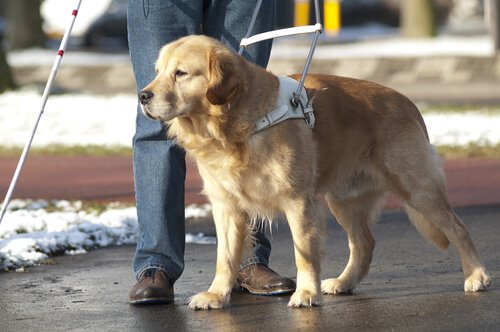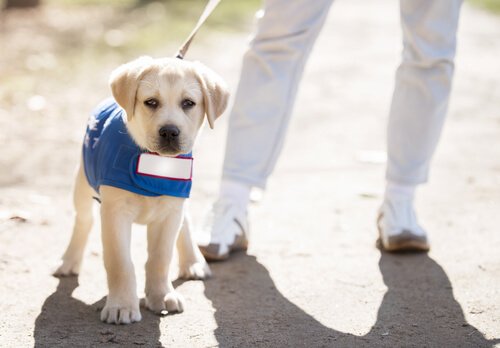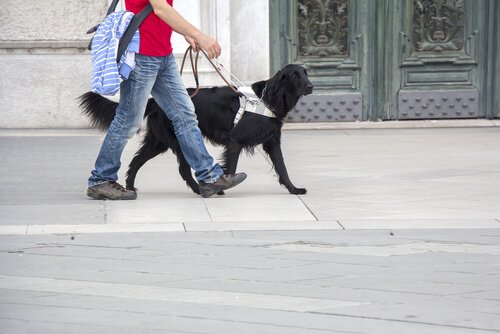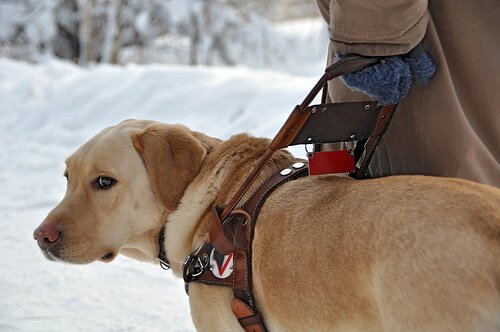What's The Life Of A Guide Dog Like?
A guide dog does one of the hardest jobs any dog can do. Today you can read about how their life is like. We’ll talk about their training and what they have to do on a daily basis for the people they work for.
What a guide dog does on a daily basis
A guide dog helps people who are blind or visually impaired. They help them walk down the street, show them when and where it’s safe to cross and go with them on public transportation.
They also help them inside the home. For example, they pick up things that have fallen and move objects out of the way for their owner. For people with limited mobility, they also help them open doors and drawers.

Unlike other professional dogs, like police dogs, a guide dog doesn’t get to rest. They pretty much are their owner’s eyes and they are with that person constantly. They require very special, intense training because it involves them knowing a lot about human social norms.
The beginning of a guide dog’s life: when it’s a puppy
Guide dogs are born at associations that will train and give them to the people they’ll help for their entire lives. These places have done a genetic selection to find the best personality and temperament for this kind of dog.
The most common guide dog breeds are Labrador Retrievers, Golden Retrievers, and German Shepherds. Their personality fits the profile because they’re smart, patient but determined, and know how to make decisions. They’re also born in a highly controlled environment where people make sure there are no complications during pregnancy and childbirth.
Unlike police dogs, guide dog training doesn’t start when it’s a puppy. These dogs will spend their first years of life with a foster family. That family’s job is to show them the world and teach them to behave well all the time.

The guide dog puppy goes back to the association once they turn 1 year old. By that time these dogs have learned to live with a family, be on the street, know how to interact with people and dogs, and behave properly in restaurants, workplaces, and public transportation, then they are for training.
Training
Once back at the association, the future guide dogs start their training. A team of professionals teaches them things that aren’t easy for a dog, such as crossing the street safely, avoiding distractions (greeting other dogs), and walking in a straight line.
They also learn to identify steps and stairs, and to keep their owner from going through dangerous areas, places with low branches or awnings that he/she might run into. These dog’s job is to help their owner stay safe when they’re out of the house.
They teach all these skills over a one-year period. Once the dog is two years, they’ll be ready to graduate and be with an owner for the rest of their working life.

Not every dog completes the training at a high enough level because they can’t concentrate or are unable of learning as fast as they should. If they don’t become a guide dog, then the association puts them up for adoption for a family that doesn’t need a guide dog.
Adult life and work as a service dog
The life of a guide dog truly starts when they meet their owner. Once they have graduated, they choose someone who has applied for this kind of assistance and start an adaptation period where the owner has to learn to understand what their dog is telling them.
Then, they’re ready to go home and live together. The dog will always be legal property of the association that trained them, and they take care of their diet and veterinary care. They play a role in their health and well-being until their working life is over.
The moment the adaptation period is over, this dog’s life is all about their owner. They will work 24 hours a day without rest, because there’s as much to do at home as there is on the street.

Guide dogs usually work until they’re about 10 or 12. However, they can always go into early retirement due to health issues — theirs or their owner’s. Anyway, that’s just to give you an idea, this should always be on a case to case basis.
When they reach that age, their future has to be decided: adoption by their owner or by another family without special needs. Either way, they’ll stop working and start to act, and live, like any other pet.
Controversies
A lot of trainers have questioned the training and life of a guide dog. Some people are also developing new technologies to one day replace them with machines.
A big criticism is the intense training these dogs go through. The schools that train them say they’re respectful, but ex-employees have stated that they often use harmful collars and punishment. Both of those are extremely problematic for dogs.

People also question whether a dog can be happy working 24 hours a day for most of their life. They mention how police dogs and acting dogs only work a few hours a week and have days off.
The demands on a guide dog require them to deny their basic instincts, like smelling things while they are on walks, peeing on corners, or greeting other dogs. People who have adopted former guide dogs say they come with a lot of physical and psychological trauma.
Guide dogs are a necessary part of life for a lot of people. These dogs help them live their daily lives in exchange for affection. But some people say that there are a lot of problems in how they are trained and how they are expected to live.
A guide dog does one of the hardest jobs any dog can do. Today you can read about how their life is like. We’ll talk about their training and what they have to do on a daily basis for the people they work for.
What a guide dog does on a daily basis
A guide dog helps people who are blind or visually impaired. They help them walk down the street, show them when and where it’s safe to cross and go with them on public transportation.
They also help them inside the home. For example, they pick up things that have fallen and move objects out of the way for their owner. For people with limited mobility, they also help them open doors and drawers.

Unlike other professional dogs, like police dogs, a guide dog doesn’t get to rest. They pretty much are their owner’s eyes and they are with that person constantly. They require very special, intense training because it involves them knowing a lot about human social norms.
The beginning of a guide dog’s life: when it’s a puppy
Guide dogs are born at associations that will train and give them to the people they’ll help for their entire lives. These places have done a genetic selection to find the best personality and temperament for this kind of dog.
The most common guide dog breeds are Labrador Retrievers, Golden Retrievers, and German Shepherds. Their personality fits the profile because they’re smart, patient but determined, and know how to make decisions. They’re also born in a highly controlled environment where people make sure there are no complications during pregnancy and childbirth.
Unlike police dogs, guide dog training doesn’t start when it’s a puppy. These dogs will spend their first years of life with a foster family. That family’s job is to show them the world and teach them to behave well all the time.

The guide dog puppy goes back to the association once they turn 1 year old. By that time these dogs have learned to live with a family, be on the street, know how to interact with people and dogs, and behave properly in restaurants, workplaces, and public transportation, then they are for training.
Training
Once back at the association, the future guide dogs start their training. A team of professionals teaches them things that aren’t easy for a dog, such as crossing the street safely, avoiding distractions (greeting other dogs), and walking in a straight line.
They also learn to identify steps and stairs, and to keep their owner from going through dangerous areas, places with low branches or awnings that he/she might run into. These dog’s job is to help their owner stay safe when they’re out of the house.
They teach all these skills over a one-year period. Once the dog is two years, they’ll be ready to graduate and be with an owner for the rest of their working life.

Not every dog completes the training at a high enough level because they can’t concentrate or are unable of learning as fast as they should. If they don’t become a guide dog, then the association puts them up for adoption for a family that doesn’t need a guide dog.
Adult life and work as a service dog
The life of a guide dog truly starts when they meet their owner. Once they have graduated, they choose someone who has applied for this kind of assistance and start an adaptation period where the owner has to learn to understand what their dog is telling them.
Then, they’re ready to go home and live together. The dog will always be legal property of the association that trained them, and they take care of their diet and veterinary care. They play a role in their health and well-being until their working life is over.
The moment the adaptation period is over, this dog’s life is all about their owner. They will work 24 hours a day without rest, because there’s as much to do at home as there is on the street.

Guide dogs usually work until they’re about 10 or 12. However, they can always go into early retirement due to health issues — theirs or their owner’s. Anyway, that’s just to give you an idea, this should always be on a case to case basis.
When they reach that age, their future has to be decided: adoption by their owner or by another family without special needs. Either way, they’ll stop working and start to act, and live, like any other pet.
Controversies
A lot of trainers have questioned the training and life of a guide dog. Some people are also developing new technologies to one day replace them with machines.
A big criticism is the intense training these dogs go through. The schools that train them say they’re respectful, but ex-employees have stated that they often use harmful collars and punishment. Both of those are extremely problematic for dogs.

People also question whether a dog can be happy working 24 hours a day for most of their life. They mention how police dogs and acting dogs only work a few hours a week and have days off.
The demands on a guide dog require them to deny their basic instincts, like smelling things while they are on walks, peeing on corners, or greeting other dogs. People who have adopted former guide dogs say they come with a lot of physical and psychological trauma.
Guide dogs are a necessary part of life for a lot of people. These dogs help them live their daily lives in exchange for affection. But some people say that there are a lot of problems in how they are trained and how they are expected to live.
This text is provided for informational purposes only and does not replace consultation with a professional. If in doubt, consult your specialist.








